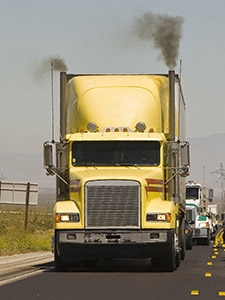
Yes, semi trucks contribute to air pollution due to their large diesel engines and heavy fuel consumption. These vehicles emit harmful pollutants such as carbon monoxide, nitrogen oxides, and particulate matter, leading to air quality deterioration.
Additionally, the high volume of freight and long hours on the road contribute to increased emissions and environmental impact. In response to this issue, there have been efforts to develop cleaner technologies and stricter emission regulations for these commercial vehicles.
With the continued growth of freight transportation, addressing the air pollution caused by semi trucks is essential for environmental sustainability and public health. This has led to a push for more sustainable practices and alternative fuel options to reduce the environmental impact of semi trucks and improve air quality.

Credit: www.mercurynews.com
Navigate As You Want: [show]
The Impact Of Semi Trucks On Air Quality
The Impact of Semi Trucks on Air Quality
Emissions from Semi Trucks:
- Semi trucks are a significant source of air pollution due to their emissions of nitrogen oxides (NOx), particulate matter (PM), and greenhouse gases (GHGs).
- These emissions contribute to the formation of smog and the deterioration of air quality, which can have adverse effects on human health.
- Semi trucks emit higher levels of pollutants compared to passenger vehicles because of their larger engines and the types of fuel they use, such as diesel.
Contributing Factors to Air Pollution:
- Factors that contribute to air pollution from semi trucks include the age and condition of the truck, the speed and type of driving, and the weight of the cargo being transported.
- Older trucks with outdated emissions control technology tend to emit more pollutants.
- Idling and stop-and-go driving in congested areas also contribute to higher emissions from semi trucks.
- Heavy loads and excessive speeding can result in fuel inefficiency and increased emissions.
Types Of Emissions From Semi Trucks
Semi trucks emit various pollutants that contribute to air pollution. Particulate matter is one of the primary emissions, consisting of tiny particles that can be harmful when inhaled. Nitrogen oxides are another significant emission, which contribute to the formation of smog and acid rain. Volatile organic compounds are released as well, contributing to the formation of ground-level ozone, a key component of smog. Additionally, semi trucks emit carbon monoxide, a poisonous gas that can be harmful to human health. These emissions collectively contribute to air pollution, impacting both the environment and public health.
Health Effects Of Air Pollution From Semi Trucks
Semi-trucks are a significant source of air pollution, leading to adverse health effects. The emissions from these vehicles contribute to respiratory problems such as asthma and bronchitis. Moreover, air pollution from semi-trucks is linked to cardiovascular issues like heart attacks and strokes. Additionally, exposure to the pollutants increases the cancer risk among individuals. Overall, the impact of semi-truck emissions on air quality and human health is a critical concern.

Credit: www.redbluffdailynews.com
Regulations And Technologies To Reduce Truck Emissions
Emission standards play a crucial role in reducing air pollution caused by semi trucks. These standards set limits on the amount of pollutants that a truck can emit. The adoption of alternative fuels is another effective way to reduce truck emissions. Fuels such as biodiesel and natural gas produce lower levels of pollutants compared to traditional diesel fuel. Advancements in engine technologies have also led to cleaner and more efficient truck engines. Technologies such as selective catalytic reduction and diesel particulate filters help to minimize harmful emissions. Additionally, aerodynamic designs and idle reduction technologies have been implemented to further improve fuel efficiency and reduce pollution. Regulations and technological advancements continue to evolve to ensure that semi trucks play their part in reducing air pollution and promoting a cleaner environment.
The Future Of Trucking And Air Quality
Semi trucks play a significant role in air pollution due to their heavy reliance on diesel fuel. However, steps are being taken to reduce their environmental impact. The future of trucking revolves around the development of electric and autonomous trucks, which aim to address the pollution issues associated with traditional diesel trucks. Electric trucks are powered by clean, renewable energy sources, significantly reducing emissions. In addition, autonomous trucks have the potential to optimize routes, reduce idling time, and enhance fuel efficiency. Innovations such as platooning, where several trucks drive closely together, can also contribute to fuel savings and reduced pollution. While these advancements are promising, the widespread adoption of electric and autonomous trucks is still a work in progress. Transitioning to greener alternatives in the trucking industry necessitates overcoming challenges such as infrastructure development and cost-effectiveness. Nonetheless, it is imperative for the industry to prioritize sustainable solutions to combat air pollution and create a healthier future.

Credit: www.wbez.org
Frequently Asked Questions Of Do Semi Trucks Cause Air Pollution
Do Semi Trucks Contribute To Air Pollution?
Semi trucks do contribute to air pollution. They emit exhaust gases like nitrogen oxides and particulate matter, which can have detrimental effects on air quality. The large size and heavy load of these trucks require more fuel and produce more emissions compared to smaller vehicles.
How Does Air Pollution From Semi Trucks Affect Health?
Air pollution from semi trucks can have negative impacts on human health. The exhaust gases they emit, such as particulate matter, can cause respiratory problems and exacerbate existing conditions like asthma. Long-term exposure to these pollutants can also increase the risk of heart disease and other chronic health problems.
What Are The Regulations On Semi Truck Emissions?
To control air pollution from semi trucks, there are regulations in place. These include emission standards set by governmental agencies that limit the amount of pollutants a truck can emit. The regulations also require the use of specific emission control technologies, such as particulate filters and catalytic converters, to reduce the harmful effects of truck emissions.
Are There Ways To Reduce Air Pollution From Semi Trucks?
There are several ways to reduce air pollution from semi trucks. These include using cleaner fuels like biodiesel or natural gas, implementing advanced emission control technologies, optimizing engine performance, and improving aerodynamics. Additionally, promoting alternative transportation modes like rail or electric vehicles for freight transportation can also help reduce pollution from trucks.
Conclusion
Semi trucks play a significant role in contributing to air pollution due to their large engines and emissions. As we explored the various factors that contribute to this issue, it becomes clear that steps need to be taken toward reducing the environmental impact of these vehicles.
Strategies such as stricter emission regulations, the use of alternative fuels, and advancements in technology can all help mitigate the adverse effects of semi truck air pollution. By implementing these measures, we can work towards a cleaner and healthier environment for everyone.



